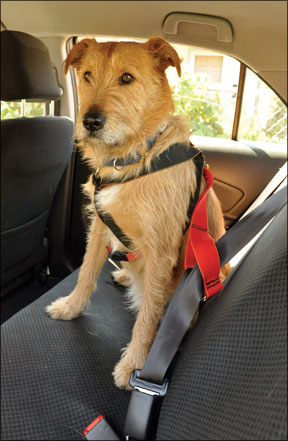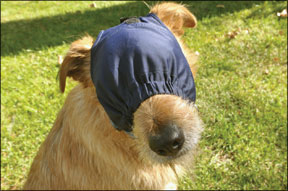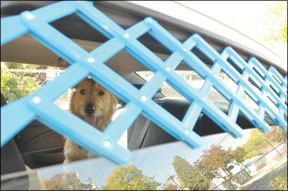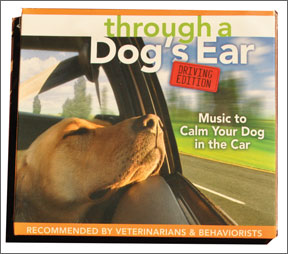Contrary to the advice I offer to clients and Whole Dog Journal readers, I admit that I’m sometimes careless about taking my dogs in the car with me. I don’t always use crates and seatbelts on short trips to town, although I always do on longer travels. Just recently, however, my husband and I loaded up all five of our dogs for their annual well-pet visit to a veterinarian, and I did take the precaution of crating everyone rather than risk canine chaos on the highway. Other than Bonnie’s panting, it was an experience in car-ride serenity, and I vowed to crate everyone, always, on future rides.

Granted, my dogs aren’t the worst in the car. They don’t sit in my lap, leap over seats, get into fights, hang out the windows, do laps around the back of the van, or bark at everything outside the car. Other than Bonnie, who pants a lot and sometimes Even so, they’re safer in crates. Loose, they are a distraction, which decreases my driving safety. Not as bad as texting, but still!
In case of an accident (heaven forbid!), loose dogs can become dangerous free-flying projectiles, slamming into seats or passenger’s heads, smashing into windshields, or escaping through broken windows to face highway hazards. Years ago, my brother lost his lovely Australian Shepherd this way; she survived the accident unscathed, but ran into highway traffic and was killed by a car. Also, loose, protective dogs can deter rescue workers from helping injured humans in the car.
At the very least, with a carload of crated dogs I don’t have to worry about someone forgetting their “Wait” training at our destination, leaping from the car when the door opens, and possibly getting hurt or lost.
So how do you take a dog who is accustomed to free range of your car when traveling, and turn him into an “easy rider?” You start outside the car.
Crates are Great
I personally prefer crates to seat belts; I think they’re safer. My dogs are all quite accustomed to crating, so it’s simply a matter of loading and securing crates in the van – that’s an important step that many people carelessly skip – and finally, putting the dogs in crates.
One small exception is Bonnie, who came to us with an aversion to riding in cars and sometimes still needs a little extra coaxing to “go to bed” in the car. With five dogs, I’d have to put the two back seats back into the van in order to use seat belts, and anyway, I find the prospect of getting all five into harness and buckled in place a little cumbersome. I can’t imagine how mothers of multiple small humans do it!
If your dog isn’t already crate-happy, you need to start there, with crate-training at home, before you can expect him to be happy about being crated in the car. (See “10 Quick Crate Training Tips”.) When your dog has come to love his crate, it’s usually a simple matter to transfer his crating behavior to the car, especially if he already loves car rides.
If your dog, like Bonnie, finds the car aversive, you’ll need to work on that piece first – but you can work on it at the same time you’re teaching him to love his crate in the house. Just don’t put them together until he loves both. When he’s happy to run into his crate and stay there, and when he’s happy to hop into the car on cue, then put the crate in the car and work on them together. When that’s working well, you’re ready to start the engine.
Seat Belts are Spiffy
There are times when seatbelts are a better option. If your car is smaller than your dog’s crate, you have no choice. If, despite your best efforts, your dog hates crates, a harness and seatbelt will be easier for you and less stressful for him. If you prefer seatbelts, there are several good products on the market. Each has strengths and weaknesses, so be sure to study up and select the one you think best meets your dog’s needs. (See “(Seat) Belt Your Dog,” February 2004). Your dog should ride in the back seat when belted; air bags can be as deadly to canines as to young children. Alternatively, if he must ride in front, disable the airbag and make sure the seatbelt arrangement doesn’t allow him access to the driver’s lap. Features of the best seat belt products include:

• A strap that hooks directly into the seatbelt mechanism rather than loops over the belt, to minimize belt play and reliance on the seat belt mechanism should you stop suddenly. (Note: It may be difficult to find products that offer this feature.)
• Good quality parts and materials that can hold up in case of impact.
• Reinforced stitching at stress points.
• Options for customized fit.
• Easy to put on the dog.
• Comfortable for the dog.
When you have identified and purchased the best seat belt for your dog, take time to acclimate him to the apparatus well before you intend to use it. This is accomplished by classically conditioning him to the harness itself, then giving him a positive association (treats!) with wearing it, and ultimately being strapped into his seat.
To condition your dog to the harness, have him target his nose to it. Hold out the harness toward him, and when he sniffs it, click a clicker (or mark the moment with another reward marker such as the word “Yes!”) and quickly give your dog a treat.
When he’s eagerly touching his nose to the harness, hold it so he can put his head through it, and click and treat him for that. You may have to ask him to target through the opening to your hand at first, but he should quickly start offering to “put it on” himself. (For more on target training, see “Right on Target,” February 2006).
Note: For an excellent video on conditioning a dog to a piece of training equipment, go to abrionline.com, click on “Videos and Podcasts” and then on “Conditioning an Emotional Response.” You will see trainer and author Jean Donaldson conditioning her Chow-mix, Buffy, to a head halter – not my favorite piece of equipment, but the principle and procedure is the same.
Training Tips
If for some reason you simply cannot crate or belt your dog safely in your car, at least take the time to train him to ride quietly, and do not let him hang out the window.

Again, start outside the car by making sure you’ve trained a solid “down” and “wait” or “stay” (see “Wait Versus Stay,” April 2009). Then practice in the car, with the car sitting still, engine off, you in the driver’s seat, your dog in the back seat. You can reinforce his down at first with treats, but fade the treats as quickly as possible and replace them with calm praise – you won’t be able to reinforce with treats while you’re driving!
When your dog will lie on the back seat quietly for 10 to 15 minutes while you read a book, start the engine. That may be enough to get him excited; if so, practice having him lie down in the back-seat with the car’s engine running yet parked, preferably in a shady and well-ventilated area!
A Few More Car Thoughts
There are a number of products and practices that can improve the quality of your and your dog’s car-travel experiences:
• Covered crates: Another benefit of the crate is that you can cover it. If your dog is reactive to stimuli outside the car, a cover over his crate can make life happier for everyone – he doesn’t react to what he can’t see, he stays calm and below threshold, and you aren’t startled while driving by his sudden outbursts.
• The Calming Cap: For a reactive dog who is either loose or seat-belted in the car, the Calming Cap is a useful tool for reducing arousal to outside stimuli. The Calming Cap, created by Trish King (training director at the Marin Humane Society) for use with dogs who get over-aroused in cars, is a sheer nylon hood that covers the dog’s eyes. He can see shapes but not detail, so he’s less reactive to the reduced intensity of the stimulus. Calming Caps are available from Premier Pet Products, premier.com or (800) 933-5595.
• Exercise: A tired dog is a well-behaved dog. A well-exercised dog is far more likely to behave well (and safely) in your car than one who is brimming with energy. Give your dog a good workout before you take him in the car, at least until his car manners are solid. If you can’t do a good physical workout, tire him mentally with brain games (see “A Puzzling Activity,” June 2008).

• Open windows: Everyone knows dogs like to stick their heads out car windows. Not everyone knows how hazardous that can be. Debris can fly into your dog’s eyes at high speed and cause injury, even blindness. “Doggles” – goggles for dogs – can help protect his eyes, but there are other hazards. Your dog can also ingest harmful particles through his nose and mouth.
A dog who hangs out a car window can suffer far worse than getting hit by a bit of airborne debris – he can fall out of the car! I was driving through downtown Hagerstown one day, behind a car with a Beagle hanging out an open window. Just as I thought, “Uh-oh, that’s scary,” the little dog fell out of the window onto the road in front of my car. I slammed on the brakes, pulled over, and helped the driver retrieve his thankfully unharmed dog.
If you must leave car windows open for your dog, please install one of several safety products designed to prevent such accidents such as the Breezeguard (an expensive but well-made product, available from muttmanagers.com, 866-653-5631), or a Vent Guard (an inexpensive but much less secure item, available in many pet supply chain stores and online outlets).
• Calming products: I spray Comfort Zone/DAP, a stress-reducing product, in Bonnie’s crate to help reduce her stress. Calming aromatherapy products (especially lavender) misted in your car may also help keep your dog calm. Also consider an Anxiety Wrap (available from anxietywrap.com, 260-344-1217) or even a snugly fitting T-shirt; this sort of swaddling can calm anxious dogs.
I’ve also seen good results from playing one of the “Through a Dog’s Ear” audio CDs for an anxious dog. A company called BioAcoustic Research and Development has developed four music CDs meant to calm anxious dogs, including one just for driving with dogs. The “driving edition” also includes some helpful instruction on preparing your dog for a calm car ride. These are available throughadogsear.com, (800) 788-0949.
Pat Miller, CPDT, is Whole Dog Journal’s Training Editor. Miller lives in Fairplay, Maryland, site of her Peaceable Paws training center. Pat is also author of The Power of Positive Dog Training; Positive Perspectives: Love Your Dog, Train Your Dog; Positive Perspectives II: Know Your Dog, Train Your Dog; and Play with Your Dog.





